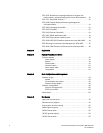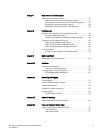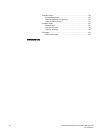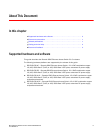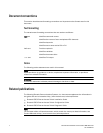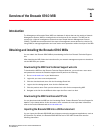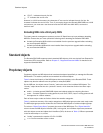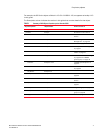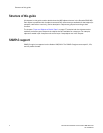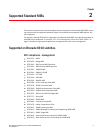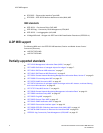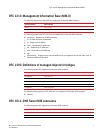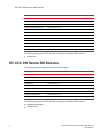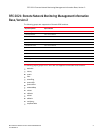2 Brocade 6910 Ethernet Access Switch MIB Reference
53-1002582-01
Standard objects
• CR/LF – Indicates the end of a line
• ^Z - Indicates the end of a file
However, in a UNIX environment, the characters LF are used to indicate the end of a line. No
character indicates the end of a file. Thus, if you need to import the Brocade 6910 MIB into a UNIX
environment, you must use a tool that converts the DOS ASCII into UNIX ASCII, such as the
dos2unix tool.
Reloading MIBs into a third-party NMS
Third party network management systems, such as HP OpenView may have problems reloading
MIB files. Ensure that you must upload the following when reloading the Brocade 6910 MIB:
• Unload the Enterprise MIBs which were installed from the previous upgrade before reloading
any new Enterprise MIB file.
• Unload the Standard MIBs which were installed from the previous upgrade before reloading
any new Standard MIB file.
Standard objects
The Brocade 6910 MIB supports certain standard MIB objects, which are derived from Request for
Comments (RFCs) documents. Refer to Chapter 2, “Supported Standard MIBs” for details on the
supported standard MIBs.
Proprietary objects
Proprietary objects are MIB objects that have been developed specifically to manage the Brocade
6910 switch. This section presents a summarized list of these objects.
Table 1 shows the hierarchy of the MIB objects that are proprietary to the Brocade 6910. These
objects may also be referred to as the private (or enterprise) MIBs.
On the MIB tree, the object named “foundry” marks the start of the IronWare MIB objects. The
“foundry” object branches into the “products” branch, which branches further into three major
nodes:
• switch – Includes general SNMP MIB objects and objects related to switching functions.
• router – Contains objects for routing protocols, such as IP, OSPF. (Layer 3 routing protocols will
be supported in a future release.)
Each of these major nodes are further divided into smaller categories.
Table 1 contains a summary of the major categories or MIB object groups under each major node.
The MIB object groups can be divided into the individual MIB objects or additional object groups.
The column “Object Group Name” presents the name of the MIB object. The “Object Identifier”
column shows the MIB object’s identifier (OID). In this guide, the IronWare objects are presented
with their object names and object their identifiers (OIDs). As shown in Table 1, OIDs are presented
in the format brcdIp.x.x.x.x, where:
• “brcdIp” represents the number 1.3.6.1.4.1.1991
• .x.x.x.x is the remainder of the number



